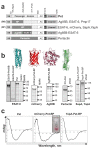A generalised module for the selective extracellular accumulation of recombinant proteins
- PMID: 22640772
- PMCID: PMC3419692
- DOI: 10.1186/1475-2859-11-69
A generalised module for the selective extracellular accumulation of recombinant proteins
Abstract
Background: It is widely believed that laboratory strains of Escherichia coli, including those used for industrial production of proteins, do not secrete proteins to the extracellular milieu.
Results: Here, we report the development of a generalised module, based on an E. coli autotransporter secretion system, for the production of extracellular recombinant proteins. We demonstrate that a wide variety of structurally diverse proteins can be secreted as soluble proteins when linked to the autotransporter module. Yields were comparable to those achieved with other bacterial secretion systems.
Conclusions: The advantage of this module is that it relies on a relatively simple and easily manipulated secretion system, exhibits no apparent limitation to the size of the secreted protein and can deliver proteins to the extracellular environment at levels of purity and yields sufficient for many biotechnological applications.
Figures




References
-
- Shokri A, Sanden AM, Larsson G. Cell and process design for targeting of recombinant protein into the culture medium of Escherichia coli. Appl Microbiol Biotechnol. 2003;60:654–664. - PubMed
Publication types
MeSH terms
Substances
Grants and funding
LinkOut - more resources
Full Text Sources
Other Literature Sources

